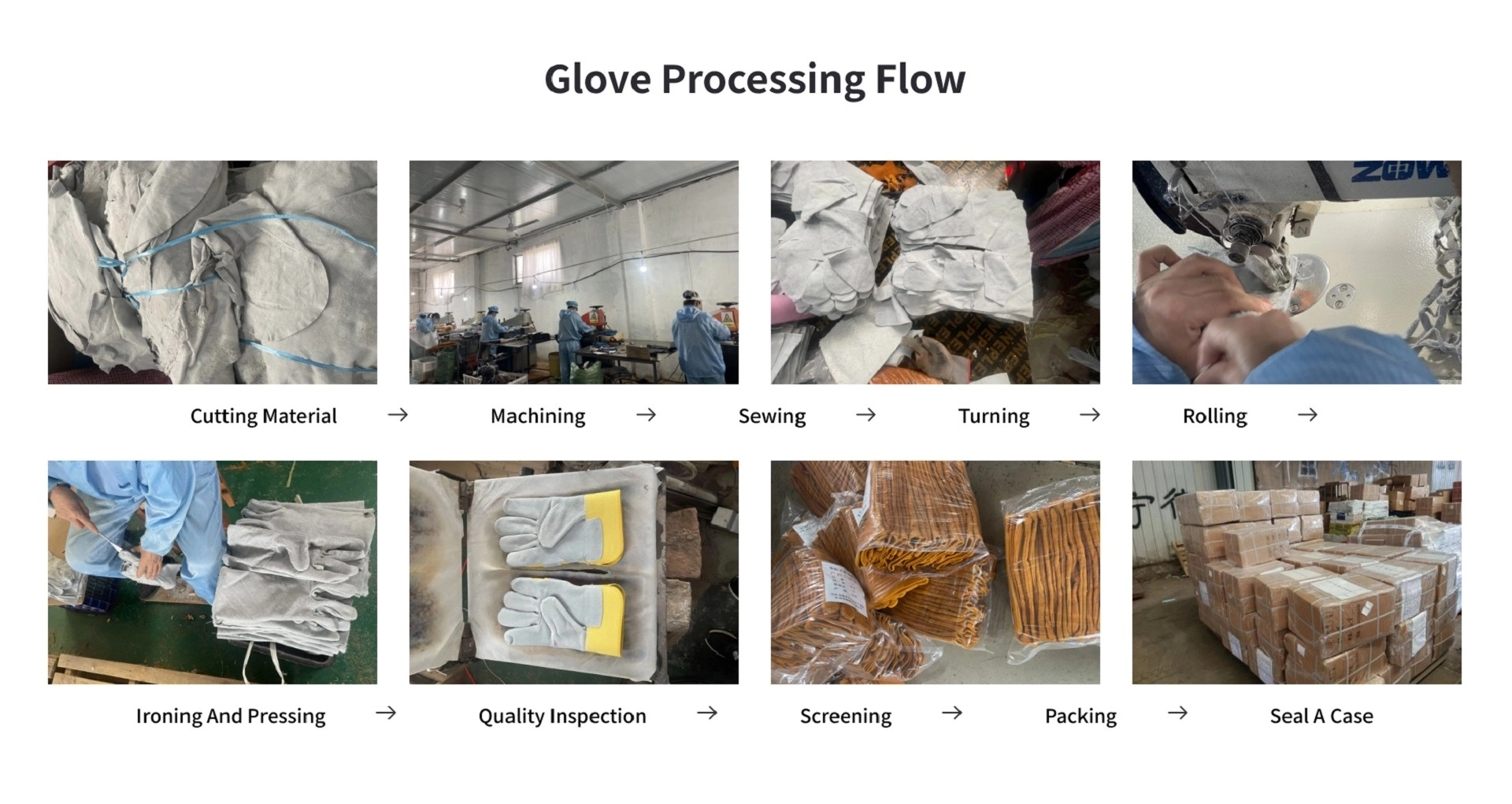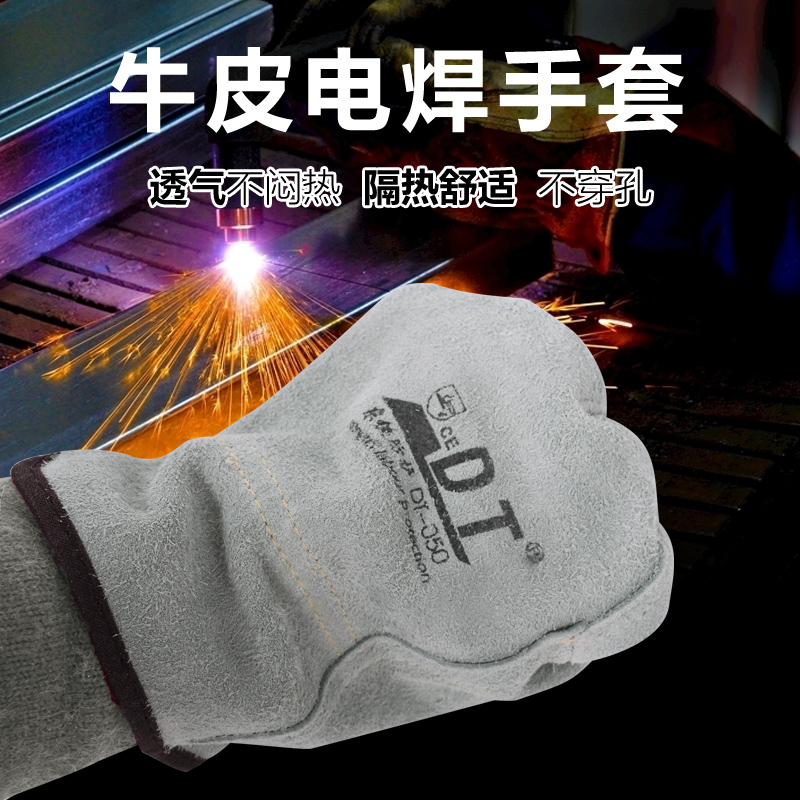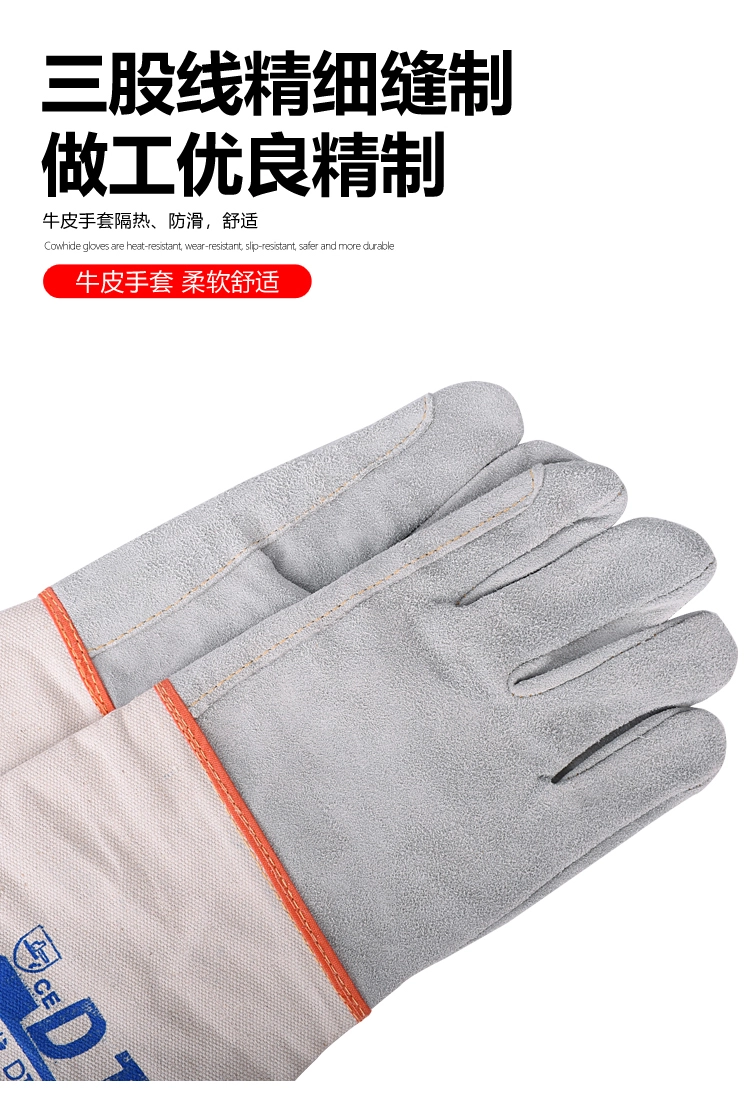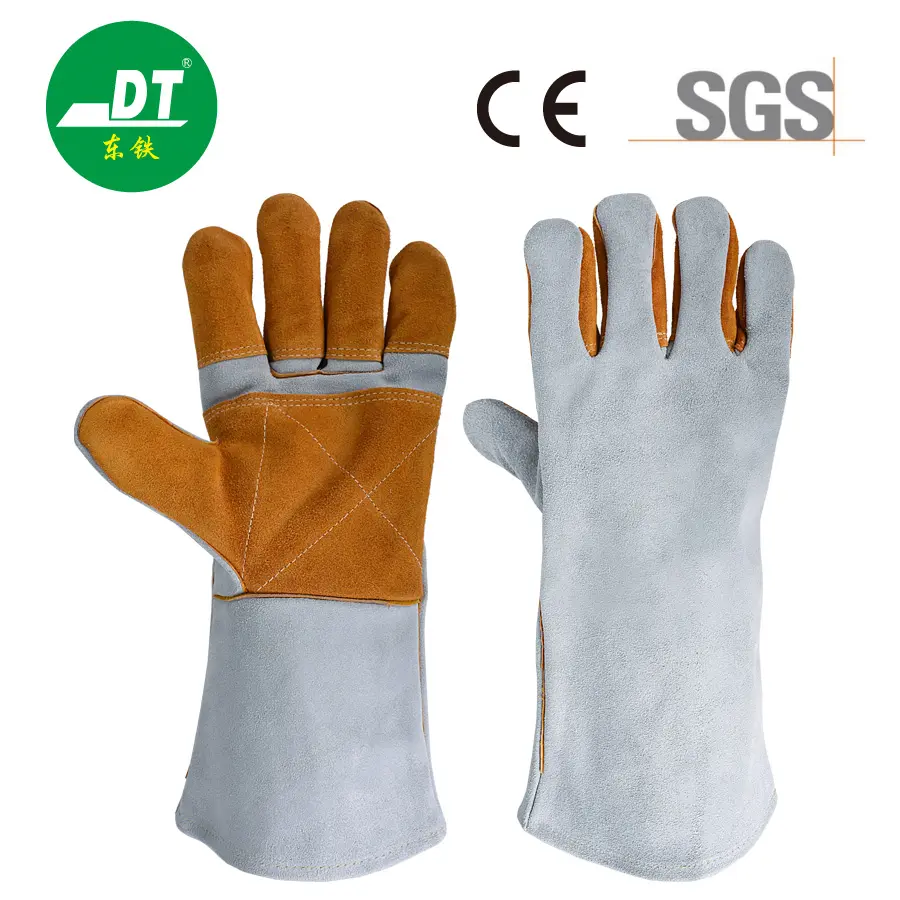Unmasking the Champion: What Type of Glove is Most Often Worn by Welders for Ultimate Protection?
Hello there! I'm Allen, and for years, my factory here in China has been dedicated to crafting top-notch protective gear, including a wide variety of welding gloves. If you're a welder, or if you're like my typical customer Mark Thompson, a procurement officer for a safety equipment distributor in the USA, you know that the right welding gloves are more than just an accessory; they are a crucial piece of personal protective equipment (PPE). This article dives deep into the world of welding gloves, exploring the different types of welding and the specific gloves is most often worn by professionals. We'll cover everything from materials to choosing welding gloves that fit your welding type, ensuring you understand why this type of glove is so popular and how to select the best protective equipment for your needs. It's worth reading because understanding these differences can significantly impact safety and efficiency on the job.
What Exactly is a Welding Glove and Why is it a Welder's Best Friend?
A welding glove isn't just any ordinary glove. Think of it as a specialized shield for a welder's hands. As someone who oversees the production of thousands of these gloves annually, I can tell you they are engineered for a tough job. The primary purpose of a welding glove is to protect the welder from the numerous hazards present during any welding process. These gloves are an essential piece of safety gear, and without them, a welder would be at high risk of serious injury. The right pair of gloves can make a world of difference in both safety and comfort.
These gloves are made from materials specifically chosen for their protective qualities. You see, welding involves intense heat, flying sparks, and sometimes even sharp metal edges. A good welding glove acts as a barrier against all these. For a welder, their hands are their most important tools, and keeping them safe is paramount. That's why a reliable pair of welding gloves is often considered a welder's best friend on the job site. They allow the welder to work confidently, knowing their hands have a strong layer of protection against heat and other dangers. The gloves provide crucial defense, making them indispensable.
Understanding the Dangers: What Do Welding Gloves Protect You From?
When it comes to welding, the environment is full of potential dangers for a welder's hands. The most obvious is the intense heat generated during welding processes. This heat can come from the arc itself, from molten metal, or from heated workpieces. A quality welding glove offers significant heat protection. Then there are sparks and spatter – tiny bits of molten metal that fly off during welding. These can cause nasty burns if they land on unprotected skin. A sturdy glove catches these fiery particles.
Beyond heat and sparks, welding gloves also protect against:
- UV and IR Radiation: The arc welding process produces strong ultraviolet (UV) and infrared (IR) radiation. Prolonged exposure can lead to "arc eye" for the eyes and skin burns similar to sunburn for the hands. A good welding glove blocks this radiation.
- Cuts and Abrasions: Welders often handle rough and sharp metal pieces. A durable glove made from tough leather can prevent cuts and scrapes.
- Electrical Shock: Some welding processes, like stick welding, involve live electrical circuits. While not their primary design, certain welding gloves can offer a degree of insulation, though specialized heavy rubber gloves are used for primary electrical protection. It's crucial to ensure the glove is dry and in good condition for any incidental protection.
From my experience working with clients like Mark Thompson, who distributes safety equipment, the demand for gloves that offer comprehensive protection is always high. Every welder needs a glove they can trust.
A Quick Look at Welding: What are the Different Types of Welding Processes?
To understand welding gloves, it's helpful to know a bit about the different types of welding, as different types of welding require different levels and types of protection. Each welding process has its unique characteristics, affecting the choice of gloves. As a manufacturer, we create gloves specifically tailored to these varying needs.
Here's a simple breakdown of common welding type methods:
- Shielded Metal Arc Welding (SMAW) / Stick Welding: This is a very common type of welding. It uses a consumable electrode (the "stick") covered in flux to lay the weld. Stick welding generates a lot of heat, sparks, and spatter. Therefore, stick welding gloves need to be thick and highly protective.
- Gas Metal Arc Welding (GMAW) / MIG Welding: MIG welding uses a continuously fed wire electrode and a shielding gas. It's generally cleaner than stick welding but still produces significant heat and spatter. MIG welding gloves need a good balance of protection and some dexterity.
- Gas Tungsten Arc Welding (GTAW) / TIG Welding: TIG welding uses a non-consumable tungsten electrode and often requires the welder to feed a filler rod into the weld pool with their other hand. This type of welding is known for precision and produces less spatter. TIG welding requires much greater dexterity, so TIG gloves are usually thinner.
- Flux-Cored Arc Welding (FCAW): Similar to MIG welding, but the electrode wire has a flux core. It can be used with or without shielding gas and often produces more smoke and spatter than MIG. The glove requirement is similar to MIG and stick welding.
Understanding these different welding processes helps us design and recommend the most suitable glove for each application. A welder performing stick welding has different needs than TIG welders.
How Does Your Welding Type Affect Your Glove Choice?
The specific type of welding you're doing is probably the biggest factor in determining the right welding gloves. As we've seen, different types of welding require different approaches to hand protection. If you're a welder, you can't just pick any glove off the shelf and expect it to work for every welding process.
For example, stick welding generates a lot of heat and spatter. So, for this type of welding, a welder needs a thick, heavy-duty welding glove, often with extra lining and reinforcement. Dexterity is less critical here than sheer protection. MIG welding is a bit of a middle ground. You still need good heat protection from the glove, but you also need a bit more feel than with stick welding. So, MIG welding gloves might be slightly less bulky. When it comes to welding with high precision, like TIG welding, the glove needs change dramatically. TIG welding requires excellent finger control to manipulate the torch and filler rod. Therefore, TIG gloves are much thinner, often made of softer leathers, to maximize dexterity. The heat is more localized in TIG welding, so a super thick glove isn't always necessary and would hinder the welder.
So, you see, the welding type directly influences the thickness, material, and design of the welding glove. A welder who does MIG and stick work might use a different glove than someone who only does TIG welding. Choosing the correct glove for the task is critical for both safety and performance. We always advise our customers to consider the primary welding tasks they'll be performing when they make their selection of welding gloves.

What are the Best Welding Glove Materials for Safety and Comfort?
The materials used in welding gloves are made to withstand harsh conditions. As a welding glove manufacturer, we work with various materials, but some are clear standouts for their protective qualities. The choice of welding glove materials is crucial for ensuring a welder's safety and comfort.
Leather is king when it comes to welding glove construction. Here are some common types of leather used in welding gloves:
- Cowhide: This is the most common material for welding gloves due to its durability, comfort, and good abrasion resistance.
- Split Leather (Suede): Taken from the bottom layer of the hide, it's more porous and offers good heat resistance and durability at a lower cost. Many general-purpose welding gloves use split cowhide. You might find chrome-tanned cowhide gloves for enhanced durability.
- Top Grain Leather: Taken from the top layer, it's smoother, more dexterous, and more oil/water resistant. Often used for TIG gloves or driver-style gloves.
- Deerskin: Very soft and supple, offering excellent dexterity. Good for TIG welding gloves where feel is important.
- Goatskin: Strong yet lightweight and supple, providing good tensile strength and dexterity. Another popular choice for TIG gloves.
- Pigskin: Tends to stay soft even after getting wet and offers good abrasion resistance.
- Elkskin: Extremely soft, durable, and heat resistant, often considered a premium material for welding gloves.
Besides leather, welding gloves often incorporate other materials for enhanced protection:
- Kevlar® Thread: Used for stitching because it's incredibly strong and heat/flame resistant. This prevents seams from burning through and the glove falling apart.
- Aluminized Backs: Materials like aluminized rayon or PFR (flame-retardant fabric) are used on the back of the glove to reflect radiant heat, ideal for high-heat welding applications. Our Kevlar with Aluminum Foil Heat Resistant Fire Retardant Gloves are a great example.
- Cotton or Wool Linings: These add insulation for extra heat protection and comfort. A soft lining can make a stiff leather glove much more pleasant to wear for long periods.
The gloves are typically made from a combination of these, ensuring the welder gets the best balance of protection, durability, and comfort. Every welder deserves a glove that feels like a second skin while offering fortress-like protection.
Beyond Materials: Key Features to Look for in Top-Quality Welding Gloves?
While the material of a welding glove is fundamental, several other features contribute to making the best welding gloves. These details can significantly impact a welder's safety, comfort, and efficiency. When customers like Mark Thompson are sourcing gloves, these are the features they, and ultimately the end-user welder, appreciate.
Here are key features to consider when choosing welding gloves:
- Heat Resistance: This is paramount. The glove must protect against contact and radiant heat produced during welding. Look for gloves specifically designed for the temperatures you'll encounter. Many types of welding require different levels of heat resistance. The type of glove is most often worn by welders is heat-resistant gloves.
- Dexterity and Fit: The glove should allow for good finger movement, especially for TIG welding. A glove that's too bulky can make precise work difficult and even dangerous. Proper fit is crucial; a glove that's too loose can slip, and one that's too tight can restrict blood flow and cause fatigue.
- Cuff Length: Welding gloves come in different cuff lengths. Longer cuffs offer more protection to the forearms from sparks, spatter, and radiation. For overhead welding tasks, a longer cuff on the glove is highly recommended.
- Lining: A soft lining (like cotton or fleece) adds comfort and extra insulation. Some gloves have moisture-wicking linings to keep hands dry.
- Reinforcements: Look for gloves with extra leather patches in high-wear areas like the palm, thumb, and fingers. This enhances durability.
- Stitching: As mentioned, Kevlar® stitching is preferred because it won't burn or break easily. This ensures the glove maintains its integrity.
- Durability and Abrasion Resistance: The glove needs to withstand rough handling and contact with abrasive surfaces. High-quality leather welding gloves generally offer good abrasion resistance.
- Compliance with Safety Standards: Ensure the gloves meet relevant safety standards like CE (Europe) or ANSI (USA). This indicates the glove** has been tested for specific protective qualities.
Finding a glove that balances these features is key. Not all welding gloves are created equal, and the best pair of gloves for one welder might not be the best for another. It always depends on the specific welding applications.
Are TIG Welding Gloves Really That Different from MIG or Stick Welding Gloves?
Yes, TIG welding gloves are quite different from those designed for MIG or stick welding, and for very good reasons. As a manufacturer, we design these gloves with specific functionalities in mind, tailored to the demands of each welding process. The main difference lies in the balance between protection and dexterity required by the welder.
Stick welding gloves and many MIG welding gloves prioritize heavy-duty protection. These welding processes typically generate more heat, sparks, and spatter. Therefore, the gloves are generally thicker, often made from heavy-duty cowhide split leather, and may feature extra layers of lining or padding for insulation. The cuffs are usually longer to protect the forearms. While these gloves provide excellent protection against heat, they offer less finger sensitivity and dexterity. For a welder doing heavy fabrication with stick welding, this trade-off is acceptable.
On the other hand, TIG welding is a more delicate art. It demands precision and fine motor control from the welder. TIG welders need to manipulate a small torch and often feed a thin filler rod by hand. This means TIG gloves (or gloves for TIG welding) must offer superior dexterity and tactile sensitivity. They are typically made from softer, thinner leathers like goatskin, deerskin, or top-grain cowhide. TIG welding gloves have a snugger fit and shorter cuffs, allowing for greater wrist flexibility. While they still offer heat protection, it’s usually less than a stick welding glove because TIG welding produces less spatter and the heat is more localized. The American Welding Society often provides guidelines that can help in understanding these distinctions.
So, while all welding gloves aim to protect, TIG gloves are engineered for finesse, whereas MIG and stick welding gloves are built for rugged defense. A welder attempting TIG welding with a bulky stick welding glove would find it incredibly challenging, and a welder using a thin TIG glove for heavy stick welding would risk burns. It's all about using the right glove for the job.

So, Which Type of Glove is Most Often Worn by Welders and Why?
Based on my experience in the industry and observing purchasing patterns from clients like Mark, the type of glove is most often worn by welders is a leather welding glove made from cowhide, specifically designed for general-purpose MIG welding and medium-duty stick welding. These gloves hit a sweet spot for versatility, durability, and protection for a wide range of common welding tasks.
Here's why this type of glove is so popular among welders:
- Versatility: Cowhide leather gloves offer a good balance of heat protection, abrasion resistance, and dexterity, making them suitable for the two most common welding processes: MIG and stick welding. Many welders perform both types of work and prefer a single, reliable pair of gloves.
- Durability: Cowhide is a tough material that can withstand the rigors of daily welding. A well-made cowhide welding glove can last a considerable time, even with frequent use.
- Protection: These gloves provide adequate protection against the heat, sparks, and spatter typically encountered in MIG and stick welding. They often feature a lining for added insulation and longer cuffs for forearm protection. Our durable 14-inch thick palm welding protective gloves are a prime example of this popular glove category.
- Cost-Effectiveness: While not the cheapest glove available, good quality cowhide welding gloves offer excellent value for money given their lifespan and protective capabilities. This is an important factor for both individual welders and companies purchasing personal protective equipment in bulk.
- Comfort: Modern leather welding gloves are designed with ergonomics in mind. Pre-curved fingers and softer linings contribute to a more comfortable fit, reducing hand fatigue for the welder.
While specialized gloves like thin TIG gloves or highly insulated gloves made for high-amperage work are essential for those specific tasks, the general-purpose cowhide MIG/stick welding glove is the workhorse often worn by welders across many industries. It's the go-to glove for a vast number of welding applications.
How Can You Choose the Perfect Welding Gloves for Your Specific Welding Tasks?
Choosing welding gloves that are perfect for your needs involves a bit more than just picking the first pair of gloves you see. As a welder, you need to consider several factors to ensure you get the right welding gloves that offer both protection and comfort. Think about the type of welding you do most often, the amperage you typically use, and the environment you work in.
Here’s a step-by-step guide to help you choose the right pair for your specific needs:
- Identify Your Primary Welding Process:
- Stick Welding: You'll need a heavy-duty welding glove with excellent heat protection and durability. Look for thick leather, lining, and long cuffs. Dexterity is secondary.
- MIG Welding: A good all-around MIG welding glove offers a balance of heat resistance and dexterity. Cowhide is a popular choice.
- TIG Welding: Prioritize dexterity and feel. Look for thinner, softer TIG gloves made from goatskin, deerskin, or supple top-grain leather.
- Consider the Amperage: Higher amperage means more heat. If you're doing high-current welding, you'll need gloves with superior insulation and heat resistance. Some specialized heat-resistant gloves even have aluminized backs to reflect radiant heat.
- Assess the Fit and Comfort: The glove should fit snugly but not too tightly. Your fingers should reach the end of the glove without feeling cramped. Poorly fitting gloves can make work difficult and even lead to accidents. Try on different sizes if possible.
- Check for Quality Construction: Examine the stitching – Kevlar® thread is best. Look for reinforced areas in the palm and thumb. The welding gloves are designed to last, so quality matters.
- Don't Forget Safety Standards: Ensure the gloves meet CE or ANSI standards. This gives you an assurance of their protective capabilities.
- Read Reviews and Get Recommendations: Talk to other welders or look for reviews online. Hearing about others' experiences with a particular glove can be very helpful.
Remember, even the best welding gloves wear out. Always inspect your gloves before each use for holes, tears, or excessive wear. If a glove is designed for protection, it must be in good condition to do its job. Taking the time to choose the right welding gloves is an investment in your safety and productivity as a welder.

Keeping Your Hands Safe: Tips for Welding Glove Care and Maintenance.
Once you've invested in a good pair of welding gloves, taking proper care of them can extend their life and ensure they continue to provide the necessary protection. As a welder, your gloves are among your most important pieces of personal protective equipment. Neglecting them can compromise your safety. Here in our factory, we stress quality materials, but user care is also vital.
Here are some tips for maintaining your welding gloves:
- Inspect Regularly: Before each use, carefully inspect your gloves for any cuts, burns, holes, or worn-out seams. If you find significant damage, especially holes that could expose your skin, it's time to replace the glove. Even a small hole can allow sparks or molten metal through.
- Keep Them Clean (Relatively!): Welding gloves can accumulate dirt, grease, and metal particles. While they'll never be pristine, you can brush off loose debris. Avoid soaking leather gloves in water, as this can make them stiff and brittle when they dry. If they do get wet, let them air dry slowly away from direct heat.
- Store Properly: Store your gloves in a cool, dry place away from direct sunlight, moisture, and extreme temperatures. Don't just toss them in a heap with sharp tools that could puncture or damage the glove.
- Don't Use Damaged Gloves: This might seem obvious, but sometimes there's a temptation to "just finish this one weld." If your glove is compromised, it's not worth the risk. Burns from the heat generated during welding processes can be severe.
- Understand Material Limitations: Remember that different gloves are made from materials with varying resistances. A glove designed for light TIG welding won't hold up to heavy stick welding. Using a glove beyond its intended purpose will shorten its life and reduce its protective qualities.
- Have a Backup Pair: It's always a good idea for a welder to have a spare pair of gloves on hand. This way, if your primary pair of welding gloves gets damaged or excessively wet, you can switch to a fresh glove without interrupting your work or compromising safety.
Proper care ensures your gloves provide the protection they were designed for. The heat-resistant gloves in welding are critical, and their integrity must be maintained. Simple maintenance can make a big difference to the longevity of your glove.
What Should You Look for in a Reliable Welding Glove Supplier?
Finding a reliable supplier for welding gloves and other protective equipment is crucial, especially for businesses like Mark Thompson's that distribute these products or for companies that need to outfit their entire workforce of welders. As a factory owner (Allen here!), I understand the importance of a strong supplier-partner relationship.
Here are some key factors to consider when choosing a supplier for your welding gloves:
- Product Quality and Consistency: The supplier should offer high-quality gloves made from durable materials with consistent manufacturing standards. Ask for samples to inspect the welding glove materials, stitching, and overall construction. You need gloves that ensure the safety of the welder.
- Compliance and Certifications: Ensure the supplier's gloves meet relevant safety standards (e.g., CE, ANSI). Ask for documentation of these certifications. This is a non-negotiable aspect when it comes to welding** safety.
- Range of Products: A good supplier will offer a comprehensive selection of welding gloves suitable for different types of welding, including MIG welding gloves, stick welding gloves, and TIG welding gloves. They should also offer other related PPE like our Heat and Flame Resistant Cowhide Welding Work Apron or the Dongtie Flame Retardant Cotton Welding Cap.
- Communication and Support: Efficient communication is key. Your supplier should be responsive to inquiries, provide clear information, and offer good customer support. This helps avoid misunderstandings and delays, which can be a major pain point.
- Experience and Reputation: Look for a supplier with a proven track record in the industry. Experienced manufacturers understand the needs of a welder and the importance of quality control.
- Logistics and Lead Times: Discuss shipping options, lead times, and their ability to handle bulk orders. Reliable delivery is essential to avoid shortages of safety gloves.
- Customization Options: Some suppliers, like us, can offer customization options, such as specific branding or minor design modifications for large orders. This can be valuable for distributors.
- Ethical Sourcing and Manufacturing: Consider suppliers who adhere to ethical labor practices and environmentally sound manufacturing processes.
Choosing the right supplier for your welding glove needs is a partnership. It's about more than just price; it's about reliability, quality, and trust. As a welder or a buyer, you want gloves and a supplier you can depend on. Many gloves are one of the most critical safety items, so this decision matters.

To wrap things up, selecting the right welding glove is a critical decision for any welder. It's not just about comfort; it's about safeguarding your most valuable tools – your hands – from the intense heat generated during welding, sparks, and radiation.
Here are the most important things to remember:
- Match the Glove to the Welding Process: The type of glove you need heavily depends on whether you're doing TIG welding, MIG welding, or stick welding. TIG welding requires dexterity, while stick welding demands heavy heat protection.
- Material Matters: Leather (cowhide, goatskin, deerskin) is the primary material for a welding glove. Features like Kevlar® stitching and appropriate lining enhance protection and durability.
- The Most Often Worn: General-purpose cowhide leather welding gloves, suitable for MIG and stick welding, are the gloves is most often worn by welders due to their versatility and balanced protection.
- Prioritize Safety Features: Look for adequate cuff length, good fit, and compliance with safety standards (CE, ANSI) when choosing welding gloves. Remember, not all welding gloves are created equal.
- Care for Your Gloves: Regular inspection and proper storage will extend the life of your welding glove and ensure it continues to protect you.
- Choose Suppliers Wisely: A reliable supplier provides quality gloves, good communication, and consistent service. The right glove from the right source makes all the difference.
As a welder, your gloves are an essential line of defense. I hope this guide helps you choose the right welding glove and stay safe on the job!






